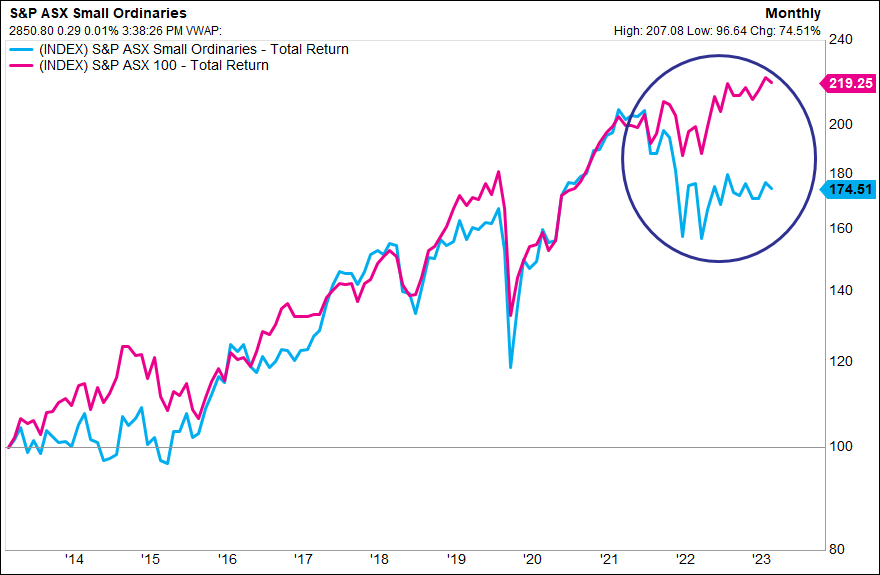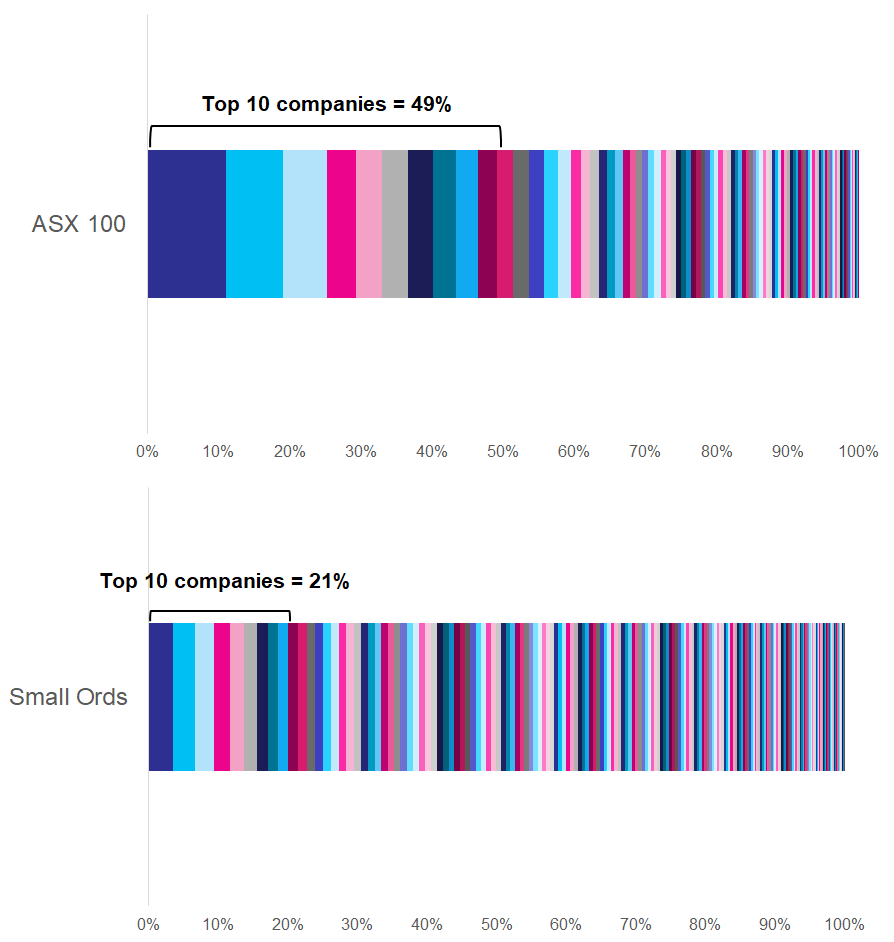Why small caps can (and will) outperform again
A lot of people, including on this platform, have started questioning whether Australian small caps will ever outperform again (which in our experience, is usually a good indicator of being at or near ‘the bottom’). When it comes to investor sentiment, it’s always darkest before the dawn.
We think that now is one of the best times to invest in smalls since the GFC.
In fact, we’ve launched our own fund – the Seneca Australian Small Companies Fund – to take advantage of what we believe will prove a fruitful period for active Aussie small-cap managers to outperform.
Defining Aussie small caps
Most analysis in the sector is predicated on the use of the S&P/ASX SMALL ORDINARIES (XSO) as the gold-standard benchmark measure of small-cap performance. While it is the best index available, the XSO is structurally disadvantaged relative to its large-cap peer, the S&P/ASX 100.
For those that are not familiar with it, the XSO is defined by S&P as the performance of companies included in the S&P/ASX 300, but not in the S&P/ASX 100.
Why have small caps underperformed?
The large cap ASX 100 index benefits from survivorship bias (the big companies get bigger). For the XSO, the opposite is true – it doesn’t ‘let your winners run’ - a lot of good stocks graduate into the ASX100 index and hence are excluded from the XSO.
Examples include:
|
Ticker |
Company |
Year graduated into ASX 100 |
|
CAR |
Carsales.Com Ltd |
2012 |
|
ALL |
Aristocrat Leisure Limited |
2012 |
|
REA |
REA Group Ltd |
2014 |
|
DMP |
Domino's Pizza Enterprises Ltd |
2015 |
|
CHC |
Charter Hall Group |
2017 |
|
CWY |
Cleanaway Waste Management Ltd |
2018 |
|
XRO |
Xero Limited |
2018 |
|
APT |
Afterpay Limited |
2019 |
|
MIN |
Mineral Resources Ltd |
2020 |
|
NXT |
NEXTDC Ltd |
2020 |
Source: S&P data, Seneca Financial Solutions
These sorts of winners, on average, outperform by +13% in the year after being included in the ASX 100.
Companies that are included in the Small Ords also include those companies that fall from the ASX 100. Based on our analysis, companies that drop out of the ASX100 as a result of what we define as “Structural Decline” on average, underperform by -9%.
Inclusions in the Small Ordinaries are also often problematic. Those names that enter the index without revenue, on average, underperform by -11%.
In summary, the composition of the Small Ordinaries Index makes it pre-disposed to apparent underperformance, relative to other Large Cap indices.
Time-series data can be misleading
Leithner predicates his analysis that small caps underperform over short, medium and long terms since 2004. Of course, returns are a function of both the start and end points selected and depending on the time period selected, data can be manipulated to support almost any narrative.
Small caps' recent underperformance (end point = today) makes returns look weaker across all previous time periods, whether it be 1 year, 3 years, 5 years, or 20 years. It’s only really the 24 months or so where returns have diverged and made the per annum returns look worse across all time horizons. You can see this clearly when visually represented.

Source: Seneca Financial Solutions, Factset
What’s been the cause of this recent underperformance?
Inflation
Small companies generally don't hold up well during inflationary periods. By definition, they are companies that do not hold dominant market positions and/or established brands and as a result, have difficulty passing on price increases to offset rising costs, relative to their larger, more established counterparts inside the ASX 100.
Consequently, small-cap valuations correlate well with bond prices (which are a good 'live' inflation proxy).

Small Ords EV/EBITDA NTM vs 5y Australian Govt Bond Yield (Inverted) over 10 years
Source: Seneca Financial Solutions, Factset
Index Breadth
The underperformance, relative to the ASX 100 can also be explained by market breadth. 49% of the ASX 100 is concentrated in the top 10 names, four of which are banks and two of which are iron-ore miners. In fact, BHP’s share price alone is 84% correlated and has an R-squared of 0.70 with the underperformance of the Small Cap index relative to the top 100.
Compare this to the diversity found across the Small Ordinaries index and it’s easy to see why periods of strong commodity prices (as we’ve recently had) asymmetrically skew returns in favour of large Australian companies.

Source: Seneca Financial Solutions, IRESS
This higher degree of market breadth is not all bad news. In fact, it is music to active manager ears! Add in lower levels of analyst broker coverage, some liquidity challenges and a general malaise towards the sector from financial advisers and retail punters alike, creating goldilocks conditions to hunt outperformance.
We analysed 97 Australian Small Cap fund managers to 30 June 2023 and found top quartile funds have outperformed the Small Ordinaries by an average of a whopping 8.0% pa over the past five years, after fees. Even more surprising is the bottom quartile manager, on average, only underperformed by -0.7% pa.
All of which says that you could have invested with almost any active, Australian small cap fund manager over the past five years and outperformed an equivalent ETF on an after fees basis.

It’s also interesting to note that the only real difference between a top and bottom-quartile Australian small cap fund manager is:
- Approximately one more negative month a year; and
- How much they make when the market is hot (max gain).
Everyone loses about 30% when the drawdowns occur, everyone bears similar volatility.
WHEN to buy small caps?
Now.
We expect small caps will close the gap to their larger counterparts, as smaller companies tend to outperform most when coming out of bear markets, with higher operating leverage to an economic recovery and rising GDP growth. History shows that this theory has worked in practice, with smalls offering significantly better returns bouncing off the economic bottom.

This theory is supported by valuation. Whether we consider the Small Ordinaries cohort on a forward PE or EV/EBITDA basis, the smaller end of the market looks great value relative to recent history.

Small caps = lower quality?
A common misconception is that buying small cap ASX shares is more akin to gambling than investing. While that may be true for many of the lower-quality microcap shares, remember that there is a far greater breadth of opportunities relative to large cap land and there are in fact many high-quality, profitable, small and mid-caps that are likely to be the success stories of tomorrow (and the shares you’ll probably kick yourself in the future for not owning today!)

As an example of what can be achieved, our particular portfolio of small companies is significantly more concentrated in higher quality businesses relative to the index and as such, we fully expect it to deliver outperformance in a range of potential market environments.

Conclusions
Australian small companies are, right now, the gift horse you're looking in the mouth. We (and everyone else in the market) appreciate that historical returns, at an index level, have been sub-par. However, as we’ve explained, the benchmark is relatively handicapped, active managers have materially and sustainably outperformed and you can build a portfolio of high-quality small companies without speculating on drill hole results or FDA approvals.
Supported by almost ‘as good as it gets’ valuations and with leverage to improving economic and operating conditions, making an allocation to one of the exceptional Australian, active, small cap managers should serve investors well over the next few years.
Thanks to Ben Richards for his contributions to this article.
4 topics
1 contributor mentioned

